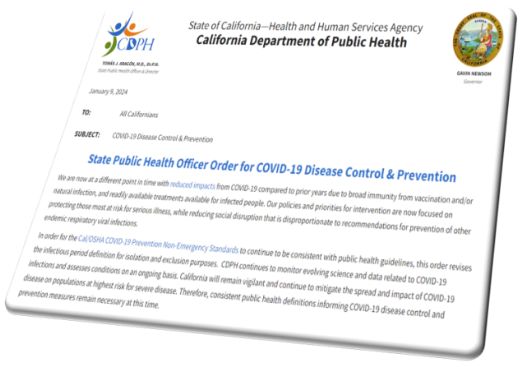On January 9, 2024, the California Department of Public Health (CDPH) issued a new State Public Health Officer Order for the Control and Prevention of COVID-19 (Order). The Order revises the definition of "Infectious Period," drastically reducing the isolation period for COVID-19 cases. This updated definition applies to Cal/OSHA's COVID-19 Prevention Non-Emergency Regulations (Cal/OSHA Covid Standard) (8 CCR 3205 et seq.).
Its incorporation carries implications that extend beyond a mere definition change, including impacting an employer's assessment of close contacts and outbreaks within the Cal/OSHA Covid Standard. In turn, Cal/OSHA has updated its FAQs for the Cal/OSHA Covid Standard to adopt the new definition and provide guidance on the associated implications.
Infectious Period
For the purpose of isolation and exclusion of confirmed cases, the Order redefines the "Infectious Period" as:
- "For symptomatic confirmed cases, from the day of symptom onset until 24 hours have passed with no fever, without the use of fever-reducing medications, AND symptoms are mild and improving."
- "For asymptomatic confirmed cases, there is no infectious period for the purpose of isolation or exclusion. If symptoms develop, the criteria above will apply."
The Order also includes a new term "potential infectious period" which is defined as "2 days before symptoms began or the positive test date (if no symptoms) through 10 days after symptoms began or testing positive."
Effect on Employers
As a result of the Order, non-healthcare employees are no longer required to exclude employees from the workplace for any amount of time if they are an asymptomatic confirmed COVID-19 case. Furthermore, employees with confirmed cases of COVID-19 can now return to work within 24-hours of the onset of their symptoms, provided they never had a fever, and their symptoms are mild and improving. In cases where a fever is present, employers must exclude the employee for at least 24 hours after the fever subsides without fever-reducing medications, and symptoms are mild and improving. With the introduction of this new Order, CDPH's isolation and exclusion requirements are now less stringent compared to the current CDC guidance, which still recommends five days of isolation for COVID-19 cases.
The Cal/OSHA COVID-19 Standard provides for the adoption of the CDPH definition of "Infectious Period." Because the term "infectious period" is included in the definition of "Close Contact" and "Exposed Group," these definitions are affected as well and should result in a lower number of close contacts and those included in an exposed group. For example, an asymptomatic confirmed case is no longer considered close contact.
However, employers should be aware that while current and previous CDPH guidance has allowed COVID-19 individuals who have ended isolation to remove their masks sooner than day 10 with two sequential negative tests one day part, the Cal/OSHA Covid Standard has not (and still does not) allow for this testing out option for COVID-19 cases. The face covering requirements pursuant to Cal/OSHA Covid Standard persist, irrespective of whether an employee with a confirmed case of COVID-19 is symptomatic or asymptomatic. Employees must continue to require COVID-19 cases to wear a face covering in the workplace until 10 days have passed since the date that COVID-19 symptoms began or, if the person did not have COVID-19 symptoms, from the date of their first positive COVID-19 test.
In addition, in a non-outbreak setting, employers must still notify all employees and independent contractors who may have had close contact with a COVID-19 case, offer testing during paid time and at no cost to any employee, provide applicable benefit information, follow return to work criteria and investigate the exposure and address hazards.
Finally, please note that if there is a local public health order in place that is more stringent than the CDPH Order or Cal/OSHA Covid Standard, that will control. Employers should review their local orders before making changes to their COVID-19 Prevention Plan (CPP). As a reminder, the requirement to have a CCP remains in place until February 3, 2025.
The content of this article is intended to provide a general guide to the subject matter. Specialist advice should be sought about your specific circumstances.



